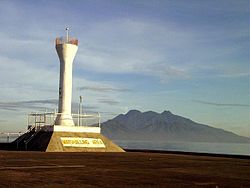Balingoan, Misamis Oriental
| Balingoan | |
|---|---|
| Municipality | |

Balingoan pier with Camiguin in the background
|
|
 Map of Misamis Oriental with Balingoan highlighted |
|
| Location within the Philippines | |
| Coordinates: 09°00′N 124°51′E / 9.000°N 124.850°ECoordinates: 09°00′N 124°51′E / 9.000°N 124.850°E | |
| Country | Philippines |
| Region | Northern Mindanao (Region X) |
| Province | Misamis Oriental |
| District | 1st district of Misamis Oriental |
| Founded | March 1, 1952 |
| Barangays | 9 |
| Government | |
| • Mayor | Pedro Panulaya |
| Area | |
| • Total | 57.80 km2 (22.32 sq mi) |
| Population (2015 census) | |
| • Total | 11,051 |
| • Density | 190/km2 (500/sq mi) |
| Time zone | PST (UTC+8) |
| ZIP code | 9011 |
| IDD : area code | +63 (0)88 |
| Income class | 5th municipal income class |
| 104303000 | |
| Electorate | 7,837 voters as of 2016 |
| Website | www |
Balingoan is a fifth class municipality in the province of Misamis Oriental, Philippines. According to the 2015 census, it has a population of 11,051 people.
Balingoan is politically subdivided into 9 barangays.
Formerly part of Talisayan, it gained independence on March 1, 1952. According to the local legend,it derived its name from the word "baling ni juan" (John's Fishing Net), which later on became simply as "Balingoan".
Produce: Copra, fish, sea shells, fruits, vegetables, animal meat, and dairy products.
Feast day: May 29. Patron Saint: San Alonzo de Rodriguez
Port of Balingoan is the main port for travellers going to the provincial island of Camiguin. From Cagayan de Oro to Balingoan is about 86 kilometres (53 mi) and would take around 1.5 hours bus ride.
There are 9 Public Elementary Schools situated in Barangays San Alonzo, Bauk-bauk, Lapinig, Mantangale, Mapua, Kauswagan, Kabulakan, Dahilig and Kabangasan.
...
Wikipedia

